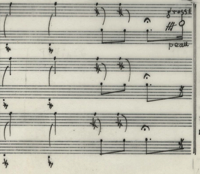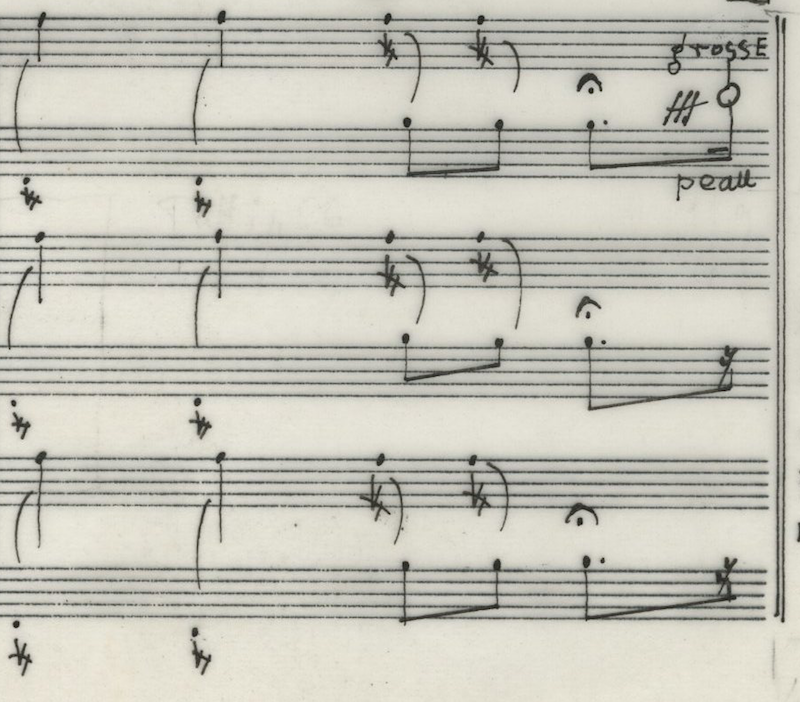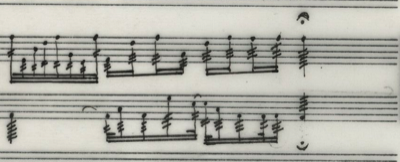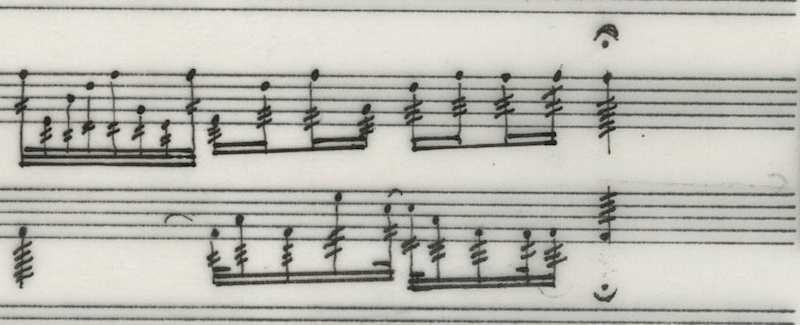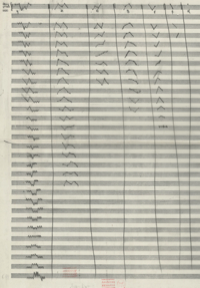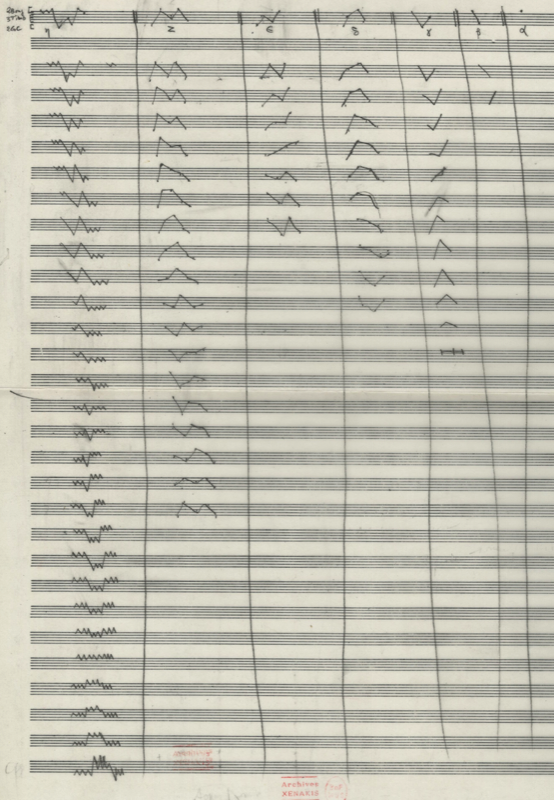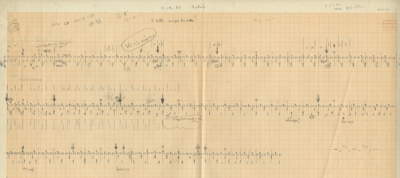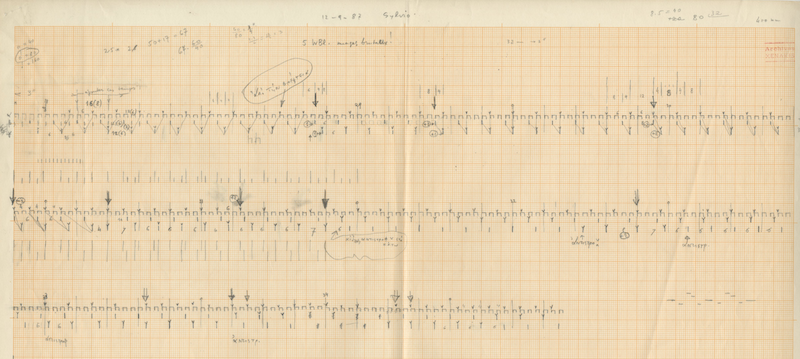Improving the practice and performance of contemporary music
Macro structure
all examples on this page are published with permission of collection Famille Xenakis. DR. and may not be copied unauthorized without permission.
General
Both movements do not seem to have so much in common as one would think. Since Rebonds B was written first in 1987 (Rebonds A was written in 1989) we can assume that the initial iambus rhythm written in the first sketch of Rebonds B (and copied from Oresteia, see below) was an influence for the later use of this same iambus rhythm in Rebonds A. Additonally, this same iambus rhythm was applied in Psappha (1975) to one of the voices as we will see further on, so we can not be absolutely sure about this.
Rebonds A
As we will see later on, Rebonds A and Okho have more in common than a clear destructive ending (1). Okho is even more extreme in this matter than Rebonds A: the piece builds up in all musical parameters to the very last bar and collapses there into a rallentando of five tutti strokes and a final convulsion of the “grosse peau profonde” (2).
In Rebonds A we see in the sketches that the composer actually composed the piece only until measure 50 (3).
From measure 51 on in the final version of the score the piece seems to be “breaking apart” again into a written out rallentando, mostly involving the two extreme instruments of the set-up: the high bongo and the large bass drum. This time the rallentando stretches over the last ten measures of the piece to finish with a pianissimo bass drum stroke.
Rebonds B
The ending of Rebonds B is slightly ambiguous: Of course the very last bar of the piece is a clear example of a “coupure au couteau” (4) ending: the fortissimo roll section at the end breaks off into silence after the last bar.
However, while examining the sketches of this piece, we remarked that from the pianissimo roll section in bar 65 onward, the composer didn’t use calculations as he used until this point but wrote the ending in a kind of “intuitive” way. It almost looks as it is written out in one pen stroke.
From this point on, Xenakis uses the woodblock as a clear structural element in the composition and it almost seems like the woodblock material is slowly “eating away” the carefully composed material from before. In this way the formal structure of Rebonds B could be looked upon as a “positive destructive” scenario, where the “parasite” material slowly takes the place of the initially composed material (5).
Commutative Property
Xenakis states on the preface of the score that the performer can choose the order in which both of the movements of “Rebonds” are performed. This of course refers to the basic mathematical principle of commutative property (6) that states that a + b = b + a or a x b = b x a: Translating this principle to musical language means that the order in which the movements are performed doesn’t affect the actual content. This is a principle Xenakis himself refers to in his theoretical work “Formalized Music” (7).
Ancient Greek poetry and metrical feet
Both movements of “Rebonds” seem to be based on an iambic foot (short – long), as Xenakis also used as a basic element in Psappha and as described by Ellen Rennie Flint in her article about this composition (8). Rebonds A (1989) is based on seven elements as displayed in the sketches: a, b, c, d, e, f, g. The first element, a single stroke, is actually not used in the piece (maybe only at the end of the piece, but in a very scattered way). The second element is an iambus, the third element becomes an anapest. The last four elements are extensions and elaborations of the first poetic based elements. The extensions start to contain what we call “noise” from the last element on. All these seven elements have possible transformations listed in the sketches.
The initial sketch of Rebonds B (1987) states a steady pulse conducted by a high instrument, accompanied by an iambic foot in the two lower parts. The three voices shift over each other by adding or detracting from the initial sieve (see below in the chapter “Sieves”) that is linked to every voice. As Xenakis states in Greek in the sketch itself, this “pattern” is literally taken from the first measures of the part “Kassandra” in his Opera Oresteia (1965-66,rev.1969/87/89).
In these same initial sketches of Rebonds B we find the phrases written in Greek: “inversions of the low voices or the accents of the low voices”. Comparing the dates written on the sketches of the two movements and certainly the “first” sketch of Rebonds B, we could assume that, since Rebonds B was written two years earlier, it was an influence for the material used in Rebonds A.
Notes
Text written by Tom De Cock © Living Scores 2015
- BARTHEL-CALVET, Anne-Sylvie, Le rythme dans l'oeuvre et la pensée de Iannis Xenakis, thèse de doctorat. Paris, Ecole des Hautes Etudes en Sciences Sociales, 2000, 2 vol., 700 + 482 p.: p. 580
- Literally “large low sounding skin instrument” meaning a bass drum or low membranophone. Xenakis also states on the first page of the manuscript score “peau africaine de grande taille” which could refer to a “dundun” kind of instrument.
- The sketches are written out until quarter note “200” which equals measure 50 if every measure contains 4 quarter notes. It is also possible that a later version of sketch of this piece is lost in the archives. This however is impossible to prove with the resources we have at our disposition.
- BARTHEL-CALVET, Anne-Sylvie, Le rythme dans l'oeuvre et la pensée de Iannis Xenakis, thèse de doctorat. Paris, Ecole des Hautes Etudes en Sciences Sociales, 2000, 2 vol., 700 + 482 p.: pp. 575-577
- BARTHEL-CALVET, Anne-Sylvie, Le rythme dans l'oeuvre et la pensée de Iannis Xenakis, thèse de doctorat. Paris, Ecole des Hautes Etudes en Sciences Sociales, 2000, 2 vol., 700 + 482 p.: pp. 558-566
- Commutative Property, 2015 (see http://en.wikipedia.org/wiki/Commutative_property)
- XENAKIS, Iannis, “Formalized Music - Thought and Mathematics in Music”, Bloomington, Indiana University Press, 1971, p. 5 and p. 157
- FLINT, Ellen Rennie, “Metabolae, Arborescences and the Reconstruction of Time in Iannis Xenakis’ Psappha”, Contemporary Music Review, 1993, Vol. 7, pp. 221-248
